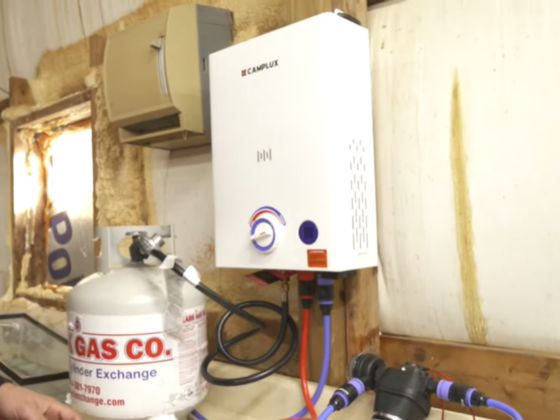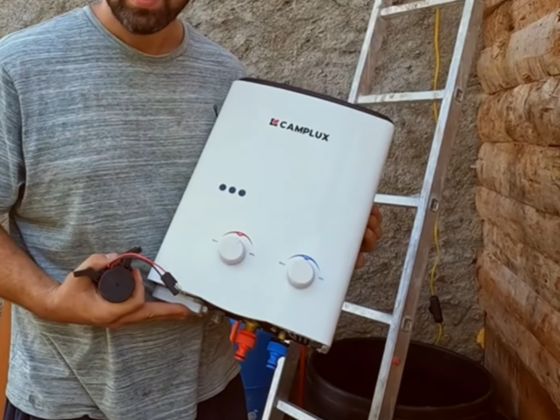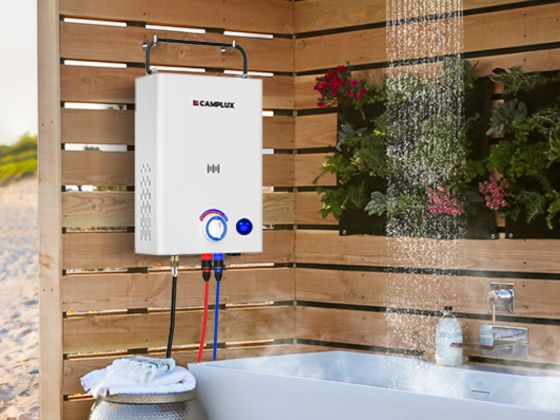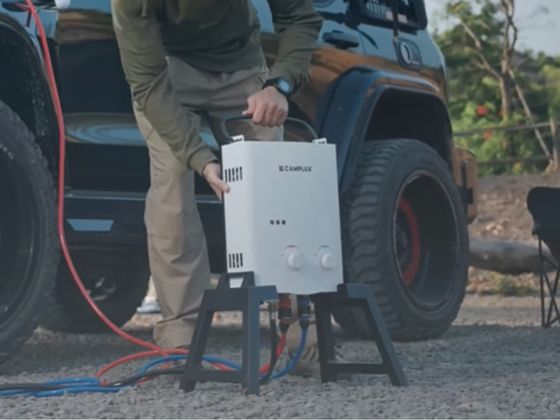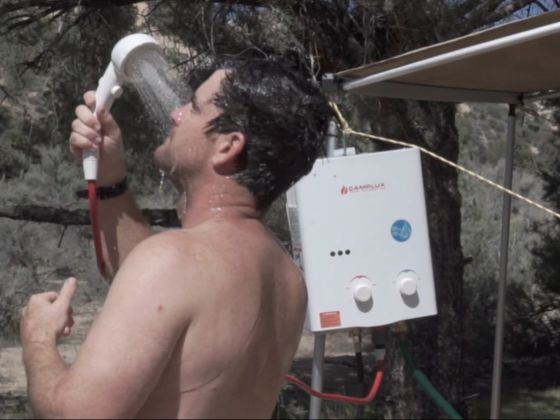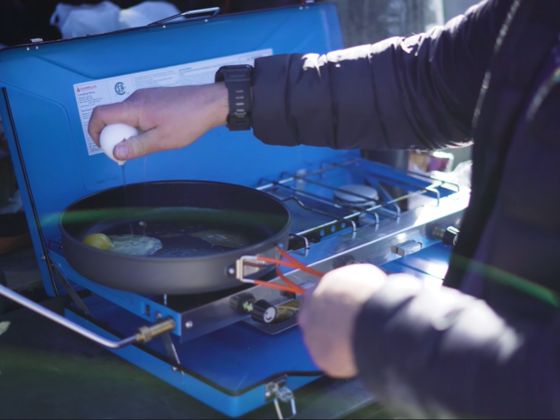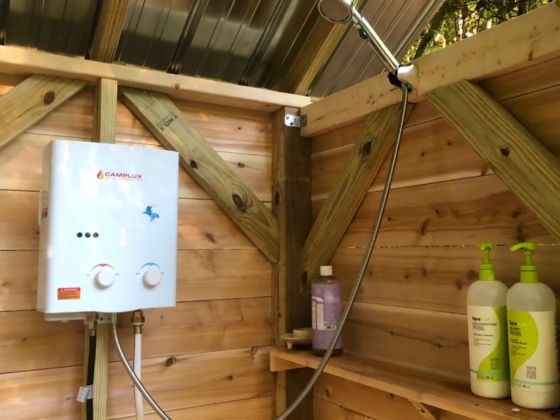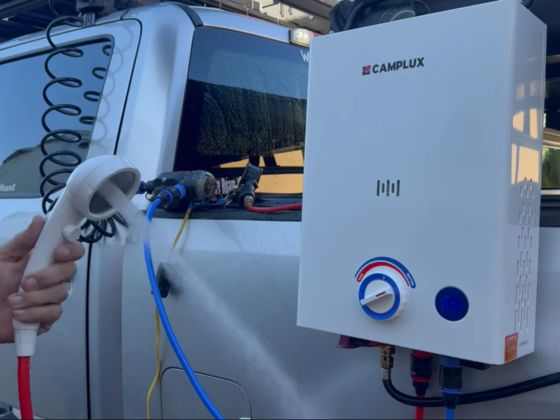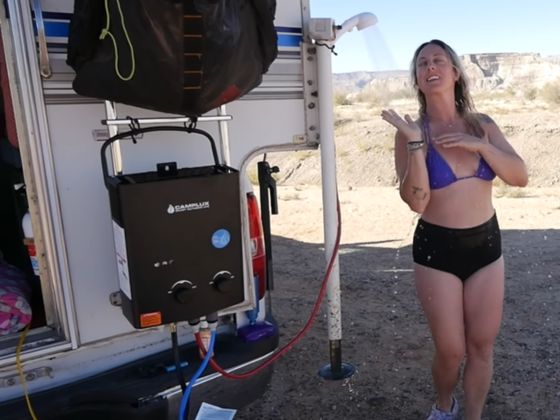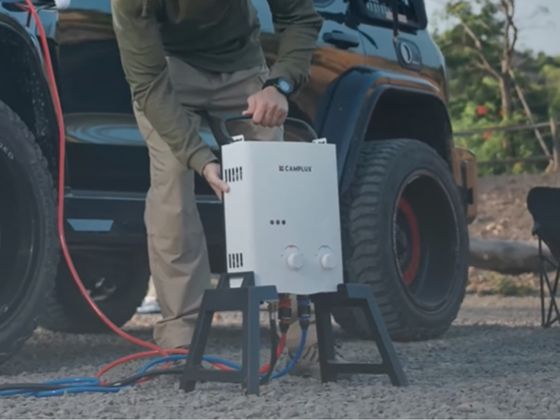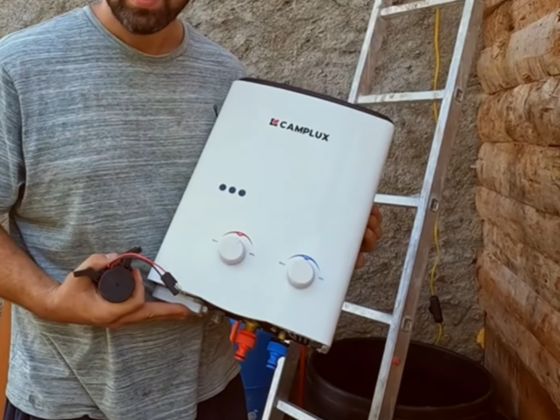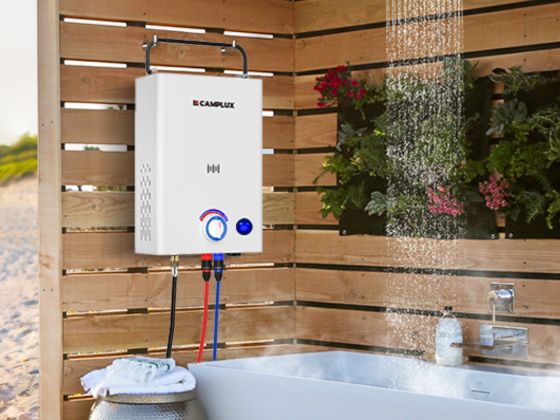If you live in a van, run an off-grid household, or call a remote Aussie property home, you know hot water can feel like a luxury. Washing up after a dusty day, giving the kids a warm bath, rinsing surfboards, or running a quick hand-wash station at a weekend market—these are the small comforts that turn the bush into a liveable backyard. A Camplux portable LPG unit makes those comforts routine. Think of it as a compact engine that turns cold water and a gas bottle into reliable, adjustable hot water almost anywhere.
1) Who This Article Helps (and Why)
This guide is for RV and van-life owners who often set up camp away from powered sites, for off-grid families who manage water and energy like pros, and for remote residents who don’t have mains at the back fence. Your pain points are familiar: cold taps in winter, washing kids and elders without shivers, dishes that never quite feel clean, and projects that leave tools caked in grease and mud. The fix is to bring a portable heat source to your water lines, instead of hauling buckets to a household heater you don’t have.
With a compact Camplux unit, you can build a hot water system on-demand that lives in your storage tub and sets up in minutes. It’s the difference between “that’ll do” and “too easy, mate.”
2) One-Sentence Takeaway
Bring hot water anywhere. With a Camplux portable LPG heater, showers, dishwashing, hygiene stations, pet baths, and gear clean-ups become quick, safe, and efficient—whether you’re parked at a beach carpark, tucked into the high country, or working a long day on a regional block.
3) How It Works (Plain-English Version)
A portable unit lives at the heart of your mobile setup. The usual bundle looks like this: an LPG cylinder, the heater itself, an inlet hose from your water source, an outlet hose to a shower head or tap, and—if your water source has little pressure—a compact 12 V pump. Hit ignition, set your preferred temperature and flow, and you’ll get steady hot water a few seconds later.
Water sources you can use: mains taps at a campground, rain tanks on the property, IBC totes, jerry cans, or even a creek (with filtration). If the water sits lower than the heater or trickles slowly, add a pump. If it’s higher or pressurised (like a tank on a stand), gravity might be enough.
What “L/min” really means: Many Camplux units are rated around 6–8 L/min. That’s the flow rate at which the heat exchanger can lift the temperature effectively. As a mental model, 6 L/min is a comfortable single shower with a mindful rinse; 8 L/min gives you a fuller spray or helps when you’ve got colder source water.
Minimum start pressure: Portable units need a small nudge from water pressure to ignite and keep the flame going. If the source doesn’t push enough, a 12 V pump solves it. Think of it like bump-starting a car: once pressure’s there, everything purrs.
Fuel and safety: This is a Gas hot water system for outdoor use. Keep the unit outside, well ventilated, and follow clearance instructions. Use a proper hose and regulator for your bottle, check for leaks with soapy water, and never run it in a closed van or tent.
4) Innovative Use-Case Library
4.1 RV & Vanlife: Turn the Outside into an Ensuite
After a day of surfing, mountain biking, or corrugated-track touring, step outside and rinse off under your own outdoor shower hot water system. You’ll protect your van’s plumbing from sand and grit, and keep moisture out of the living area. Clip a shower head to a rear door or awning pole, and add a tap splitter so someone can rinse dishes while you shower. For family trips, precise temperature control makes kids’ bath time relaxed (no goosebumps, no drama). And when you’re packing up at dusk, a warm hand-wash before dinner is pure gold.
Camplux tip: A 6–8 L/min unit gives a balanced spray without emptying your tank too quickly. If you often draw from jerry cans on the ground, a 12 V pump is your best mate. For space, store the heater in a plastic crate with hoses, quick-connects, and a collapsible basin.
Keyword used: portable hot water system for camping
4.2 Off-Grid Homes: Everyday Comforts Without Mains
Off-grid families often juggle tank height, pump lift, solar harvest, and LPG swaps. A Camplux unit slotted beside your rain tank can deliver warm hand-wash water at the back door, make winter washing-up less grim, and help with a weekly bath routine. Want a treat? Plumb a stock tank (“farm tub”) with a mixer and you’ve got a bush spa. Because you manage resources closely, dial the flow down to save water while keeping a comfortable outlet temperature.
Camplux tip: Look for low-pressure ignition and multi-layer safety (overheat cut-out, flame-failure protection). On a frosty night, drain the unit to prevent ice damage.
Keyword used: hot water system lpg
4.3 Remote Properties & Light Worksites: Wash-Downs That Win Back Time
Shearing sheds, mechanical tinkering, fencing days, or café pop-ups on a country block—work leaves a mess. A propane hot water system makes end-of-shift wash-downs faster and more thorough, lifting grease, diesel film, and mud far better than cold water. Set up a dual-basin bench: one side for suds, one for rinse, with a strict hand-wash station in the middle. Food stalls and micro-coffee bars at markets benefit too—warm water helps meet hygiene expectations and keeps gear shipshape.
Camplux tip: Choose a sturdy casing and consider simple filtration to reduce scale. Keep a spares kit: O-rings, hose washers, a small roll of thread tape, and a spare regulator if you’re far from town.
4.4 Leisure & Wellness: Backyard or Glamping “Spa”
Want a chill backyard upgrade? Hook a tub to your outdoor gas hot water system, set a sensible temperature, and settle in under the stars. At glamping sites, a privacy tent plus a heated shower turns a nice camp into a luxe retreat. The big win is stable temperature—no icy shocks if someone turns on a tap elsewhere. Kids and pets benefit from predictable warmth too; rinsing the dog is no longer a wrestling match with a cold hose.
Camplux tip: Keep anti-scald in mind. Use a mixing valve or start with a lower set-point, then “creep up” to comfort. If curious hands are around, remove the temptation by mounting the unit out of reach and locking the temperature dial.
4.5 Events & Micro-Commercial: Pop-Up Hygiene That Passes the Pub Test
Markets, fun runs, community open days, school fundraisers—most need quick hand-wash capacity and somewhere to clean cookware. A portable heater gives you hot water system instant credibility. Set up a 5-minute workflow: water in, water out, hand-wash in the middle, and do the rinse station at the end of the line. Mark a one-way traffic flow so punters don’t bunch up. For food and coffee stalls, hot water cuts through milk residue and oils better than elbow grease alone.
Camplux tip: If serving crowds, favour a model with a healthy flow rate so you don’t get queues. Bring a spare LPG bottle and label hoses by colour or tag so set-down is quick when you’re knackered.
4.6 Backup & Emergency: Comfort When the Grid Wobbles
Storms, planned outages, or pump failures happen. A gas hot water system camping setup kept in a crate becomes your household back-up. Park it outside, plumb to a jerry can or tank, and you’ve got dignified hygiene in a pinch. For temporary shelters or community responses, it helps with pet care, basic first-aid rinsing, and keeping morale up when everything else feels a bit pear-shaped.
Camplux tip: Treat safety like a checklist: outdoor ventilation, gas leak test with soapy water, flame supervision working, and a strict “no operation inside” rule—no exceptions.
5) Choosing the Right Model (AU-Focused)
When picking a heater for Australia’s mix of climates and water sources, three specs matter most:
Rated flow (L/min). More flow means a fuller spray and faster rinses, but also a higher water draw. As a rule of thumb, 6 L/min excels for single showers and dish stations; 8 L/min is great for longer hair, colder source water, or multi-person setups. If you imagine filling a 10 L bucket, 6 L/min takes under two minutes—handy for visualising usage.
Minimum start pressure. This is the “push” required to ignite. If sourcing from low-sitting containers, a 12 V pump makes life easy. If your tank’s raised on a stand, gravity might cover it.
Ignition and safety. Battery ignition keeps things simple off-grid. Safety layers like overheat cutoff and flame-failure protection are non-negotiables for outdoor gas appliances.
A quick example. The Camplux BV family is designed for outdoor use, with options in the 6–8 L/min range. A unit around 8 L/min (think of models like BV158 for reference) suits mixed family and campsite duties: showers plus a small dish station without strain. If you’re mostly solo and chasing ultra-compact packing, a smaller flow model saves space and sips water.
Add-on matrix (keep it simple):
- People & frequency: Solo/occasional → 6 L/min; Family/regular → 8 L/min
- Source & height: Low jerry cans → add pump; Elevated tank → pump optional
- Use cases: Showers + dishes → standard shower kit; Gear wash + pets → add quick-connects, collapsible basin, and a “rinse” nozzle
- Water quality: Hard water or tank sediment → inline filter, occasional descaling
Keyword used: Lpg hot water system
6) Three Ready-to-Copy Setups
Setup A: RV Exterior Shower (Fast & Tidy)
What you need: Portable Water Heater, LPG bottle with regulator, inlet hose, outlet hose with shower head, quick-connect set, 12 V pump (if using jerry cans), a collapsible basin, and a mounting point (rear door hook or pole clamp).
Five-minute steps:
- Park and pick a ventilated spot behind the van.
- Clip the heater to a temporary mount at eye height, away from awnings.
- Connect LPG and crack the valve; do a 10-second soapy-water leak check at fittings.
- Run inlet from tank/jerry can via pump (if needed).
- Attach shower head, set a mid-range temperature, test spray, and you’re off.
Why it’s brilliant: Keeps sand and wet kit outside, makes kid bath time calm, and turns a carpark into an ensuite. Pack-down is the reverse—hoses coil into a crate, and the heater stows upright.
Keyword used: instant hot water system camping
Setup B: Off-Grid Rain-Tank + Kitchen Sink
What you need: heater, LPG, inlet from rain tank (gravity or pumped), outlet to a sink with a mixer tap, and a coarse filter on the inlet.
Steps:
- Mount the heater on an exterior wall under an eave with safe clearances.
- Plumb an inlet tee from the tank line (or a small service line) to the heater.
- Feed the outlet to your sink and install a basic mixer or on/off valve.
- Prime the line, set temperature to “warm-wash” territory, and mark the dial for repeatability.
Why it’s brilliant: Dishes get done faster, hands get properly clean, and winter feels less like a punishment. It’s a small change that lifts daily quality of life.
Keyword used: outdoor gas hot water system
Setup C: Market Food Stall Twin-Basin Station
What you need: heater, LPG, water jerry can + 12 V pump, two basins (wash/rinse), hand-wash dispenser, and a grey-water container.
Steps:
- Position the heater on a stand behind the stall (open air).
- Connect the pump to your jerry, inlet to heater, outlet to a tap that feeds both basins.
- Put a small on/off shower valve on the outlet hose so you can feather the flow.
- Hand-wash station goes between basins; waste routes to a sealed container.
Why it’s brilliant: Staff keep gear clean, milk scum disappears quickly, and health inspectors see a hygienic setup. Your evening pack-down is quicker because grime didn’t bake on.
Keyword used: outdoor shower hot water system
7) Water & LPG Planning for Australia
Bottle sizes and swaps. Many travellers keep a pair of mid-size LPG bottles; run one, keep one full. That simple redundancy saves the “uh-oh” moment at 9 pm in the rain. Store bottles upright and strapped.
Water-wise habits. Fit an on/off valve at the shower head so you can “navy shower” (wet, valve off, soap, valve on to rinse). A collapsible basin cuts water use for dishes. If you’re moving camp, pre-heat a jerry and make tea or washing-up a snap on arrival.
Compliance and common sense. These are outdoor gas appliances—use them outside, with ventilation and clearances. Keep kids away from the front face, don’t enclose the unit in a sealed shower tent, and never defeat safety devices. A unit designed and labelled for Australian conditions plus an AGA-compliant setup is the safe way to go.
Keyword used: LPG gas hot water system
8) FAQs & Maintenance
Winter use? Drain the unit after use in freezing conditions so water inside doesn’t expand and crack components. A quick unscrew at the drain point and a minute of patience beats a busted heat exchanger.
Scale and filters? Hard water leaves mineral scale that reduces heat transfer. Pop a simple inline filter on the inlet and descale now and then with an approved solution. If your tank gathers sediment, a coarse pre-filter keeps the fine filter happier.
Kids, pets, and anti-scald? Start at a lower temperature, and creep up until it feels right. Add a mixing valve if you want a mechanical “cap.” Keep the heater mounted out of reach when curious hands are about.
Storage and transport? Let the unit cool, disconnect gas, drain water, and coil hoses dry. A plastic crate with dividers stops dings and makes the next setup lightning fast.
Keyword used: Instant hot water system
9) Buy Smart, Then Build
Match the unit to the job. Solo traveller rinsing off after a surf? A compact model with around 6 L/min saves water and space. Family on seasonal trips or a property owner balancing showers and a dish station? An 8 L/min model gives you a generous spray and headroom for cold-source days. If you regularly pull from low containers, plan a small 12 V pump and battery into the kit. For accessories, think: quick-connects to speed setup, a shower tent for privacy, a collapsible basin for dishes, and a simple inline filter for longer component life.
Above all, keep it practical. Hot water should be the least complicated part of your day. With Camplux, you get an on demand setup that doesn’t chew through your time or your tanks, and it turns the “middle of nowhere” into “right where we want to be.”

